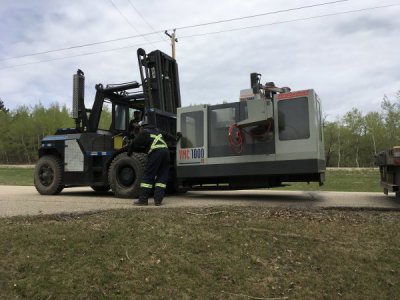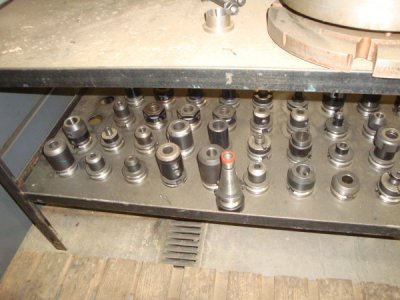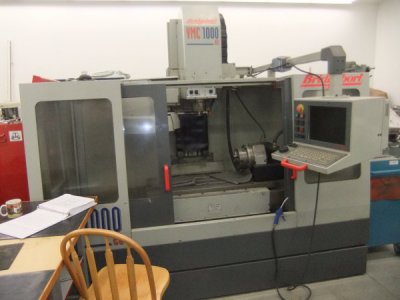- Joined
- Sep 25, 2014
- Messages
- 1,152
I'm not sure if I'm in the correct forum - after all, it is a Bridgeport machine.
This is one of those “It seemed like a good idea at the time stories”.
CNC machines just seem so cool, I wanted to have a go at it myself. Though I am not a machinist, I go into plenty of machine shops as part of my day job. CNC mills in particular seem to have practically taken over much of the milling machine space (and open up functions that would be challenging with a manual machine). I have been reading lots of “CNC mill” post here, and talking to plenty of folks about what to look for. Over the past several years I’ve looked at a several machines and “kicked tires” on a few. When a ’98, 4 axis VMC turned up in my area - off I went to heck it out. I got to see the machine run, it came with 40 assorted spindle tools, chip conveyor and the usual kit that BP fitted these VMCs (20 tool ATC, flood coolant, full enclosure, slide covers, lighting, automated way lube, air drawbar and spindle seal).
Since I had the space, and theoretically enough power in the wall (largest motor 15 HP, 20kVA machine nameplate) and a price tag less than what the tooling would have cost – I went for it. A condition of the purchase was to use a professional machine mover to get it out of the building (the move was nearly half the price of the machine). In retrospect, it was money well spent (the move went very well and the pain associated with signing the check was short lived). My little 5HP rotary phase converter was certainly not going to work out – and all recommendations were that, although a good quality rotary PC would provide power of adequate quality – for “just a little bit more, you could get a Phase Perfect”. The PP cost as much as the combined cost of the VMC machine and moving it! Now my whole shop is powered by the PP – it is much nicer than the rotary (quieter and the machines start with more authority).
I’m rationalizing the cost of the power upgrade as something I “needed”, so it does not count into the cost of the VMC .
When I got the machine home and started going over it – everything seemed to be intact, they had even cleaned it! In spite of “looking clean” – I started pulling the guards. There were chips in and under everywhere – needle like chips at that. I have spent about 60 hours just in getting all the slide covers off & on, apart (these are fitted with a very sturdy set of covers over all the slides) and vacuuming & wiping everything in sight. The machine actually powered up without issue and responds to the basic set up commands: Drives on, Home Axis, jog all 4 axis and the spindle, change tools – so far so good.
There is certainly risk in getting an old industrial machine. There is 3rd party support in my area (he has worked on this machine over the years and many BP parts are available). This was a very expensive machine back in the day – yet it seems when the software starts to fall behind, a working machine becomes a “boat anchor”. The previous owner had it for sale for quite a while with no expressions of interest. The commercial operators don’t seem to be interested for the same reason he was getting rid of it (older software – the DX-32 controller seems to be out of favor) and a small shop / home guy will struggle with space, transport or power.
I’m usually advising other hobby folks to get as big a machine as they can fit in their work space, provide power for or manage financially (even a “big” home machine is still pretty small by commercial standards). So this was a chance to try out my own advice. I can now max out my available electrical service, it takes up more space than our mini-van, and it was cheaper in cash / time for the features given, than so many builds written up on various posts and blogs. I have seen the question of getting an older commercial CNC come up a number of times here on HM. For the tiny bit I know right now, I can say I have no regrets.



This is one of those “It seemed like a good idea at the time stories”.
CNC machines just seem so cool, I wanted to have a go at it myself. Though I am not a machinist, I go into plenty of machine shops as part of my day job. CNC mills in particular seem to have practically taken over much of the milling machine space (and open up functions that would be challenging with a manual machine). I have been reading lots of “CNC mill” post here, and talking to plenty of folks about what to look for. Over the past several years I’ve looked at a several machines and “kicked tires” on a few. When a ’98, 4 axis VMC turned up in my area - off I went to heck it out. I got to see the machine run, it came with 40 assorted spindle tools, chip conveyor and the usual kit that BP fitted these VMCs (20 tool ATC, flood coolant, full enclosure, slide covers, lighting, automated way lube, air drawbar and spindle seal).
Since I had the space, and theoretically enough power in the wall (largest motor 15 HP, 20kVA machine nameplate) and a price tag less than what the tooling would have cost – I went for it. A condition of the purchase was to use a professional machine mover to get it out of the building (the move was nearly half the price of the machine). In retrospect, it was money well spent (the move went very well and the pain associated with signing the check was short lived). My little 5HP rotary phase converter was certainly not going to work out – and all recommendations were that, although a good quality rotary PC would provide power of adequate quality – for “just a little bit more, you could get a Phase Perfect”. The PP cost as much as the combined cost of the VMC machine and moving it! Now my whole shop is powered by the PP – it is much nicer than the rotary (quieter and the machines start with more authority).
I’m rationalizing the cost of the power upgrade as something I “needed”, so it does not count into the cost of the VMC .
When I got the machine home and started going over it – everything seemed to be intact, they had even cleaned it! In spite of “looking clean” – I started pulling the guards. There were chips in and under everywhere – needle like chips at that. I have spent about 60 hours just in getting all the slide covers off & on, apart (these are fitted with a very sturdy set of covers over all the slides) and vacuuming & wiping everything in sight. The machine actually powered up without issue and responds to the basic set up commands: Drives on, Home Axis, jog all 4 axis and the spindle, change tools – so far so good.
There is certainly risk in getting an old industrial machine. There is 3rd party support in my area (he has worked on this machine over the years and many BP parts are available). This was a very expensive machine back in the day – yet it seems when the software starts to fall behind, a working machine becomes a “boat anchor”. The previous owner had it for sale for quite a while with no expressions of interest. The commercial operators don’t seem to be interested for the same reason he was getting rid of it (older software – the DX-32 controller seems to be out of favor) and a small shop / home guy will struggle with space, transport or power.
I’m usually advising other hobby folks to get as big a machine as they can fit in their work space, provide power for or manage financially (even a “big” home machine is still pretty small by commercial standards). So this was a chance to try out my own advice. I can now max out my available electrical service, it takes up more space than our mini-van, and it was cheaper in cash / time for the features given, than so many builds written up on various posts and blogs. I have seen the question of getting an older commercial CNC come up a number of times here on HM. For the tiny bit I know right now, I can say I have no regrets.



